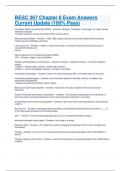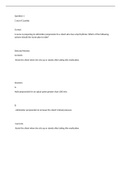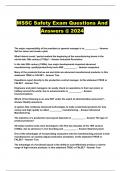BESC 367 Chapter 8 Exam Answers
Current Update (100% Pass)
Hazardous Waste (as defined by RCRA) - Answers -Mutagen, Teratogen, Carcinogen: (in order) causes
hereditary changes
through mutations; causes fetus deformities; causes cancer
Minamata Bay disease - Answers -(1932-1968, Japan) physical and mental impairments caused by
methyl mercury (CH3Hg)+ poisoning
Love Canal, NY - Answers -(1950s +) chemicals buried in old canal; school and homes built over it;
caused birth defects and
cancer
Main component of municipal solid waste (MSW):
127): - Answers -paper; most is landfilled
Sanitary landfill problems and solutions - Answers -problem = leachate; solution = liner with collection
system
problem = methane gas; solution = collect gas and burn
problem = volume of garbage; solution = compact and reduce
Incineration advantages - Answers -volume of waste reduced by 90%, and waste heat can be used
Incineration disadvantages - Answers -toxic emissions (polyvinyl chloride, dioxins), scrubbers and
electrostatic precipitators
needed, ash disposal (contains heavy metals)
Best way to solve waste problem - Answers -reduce the amounts of waste at the source (source
reduction)
Hooker Chemicals and Plastics Corporation. - Answers -The company responsible for the dumping of
toxic and cancer-causing wastes into an old canal excavation called the Love Canal
an elementary school and housing project - Answers -After Love Canal was abandoned, it was sold and
used for
less than 2% - Answers -Garbage produced directly by households and businesses accounts for ____%
of the solid waste produced in the United States
30%. - Answers -The recycling/composting rate of U.S. municipal solid waste is about
discarded computer printer paper - Answers -not a type of e-waste
Massachusetts - Answers -U.S. state first to ban the disposal of computer and TV sets in landfills and
incinerators
Canada - Answers -is not one of the countries that receives a large percentage of the United States' e-
waste?
Pakistan, Nigeria, India, China - Answers -countries that receives a large percentage of the United States'
e-waste?
,Repurpose - Answers -Using a tire to make a swing is an example of ____.
Recycle - Answers -which of the five Rs is the least desirable from an environmental standpoint?
reducing the amount of materials used - Answers -Which is the most advanced approach
49% - Answers -Currently, the United States recycles about ____ of all its wastepaper.
Recycling paper - Answers -saves energy.
creates jobs and saves money.
conserves water and landfill space.
decreases production costs.
plastic - Answers -most difficult to recycle is
1)They serve as breeding grounds for mosquitoes that can transmit diseases 2)They can burn for weeks
to years in highly polluting fires - Answers -Why are tires health hazards?
gasoline - Answers -has not been "linguistically detoxified
20 - Answers -The EPA estimates that approximately ____ tons of hazardous wastes are produced for
each person in the United States per year.
95 - Answers -percent of the U.S. hazardous waste is not regulated by hazardous-waste laws.
less visible than other waste-disposal methods - Answers -Deep-well disposal of liquid hazardous wastes
is
cost - Answers -disadvantage of using a plasma torch to detoxify hazardous waste?
incineration - Answers -Which of the following methods of hazardous waste conversion methods requires
temperatures of up to 2,000 degrees C?
the disposer of the waste - Answers -the real cost of dumping hazardous wastes is borne by the
lead - Answers -serious pollutant that accumulates in human bones because it is not excreted is
lead may cause - Answers -partial paralysis, mental retardation, palsy, nueological damage
Eco-industrial revolution - Answers -its goal is to make industrial manufacturing processes cleaner and
more sustainable by redesigning them to mimic nature's way of dealing with waste
brownfields - Answers -an abandoned or unused, contaminated piece of industrial or commercial property
that is available to reuse
material flow economy - Answers -buying goods outright
service flow economy - Answers -eco-lease services; easier to reuse and recycle
Eco-leasing - Answers -renting services that goods provide
tool libraries - Answers -an example of reuse, people check out a variety of power and hand tools
recycling - Answers -collecting and reprocessing a resource so that it can be made into new products
primary recycling - Answers -close-loop, materials are recycled into new products of the same type
,secondary recycling - Answers -materials are converted into different products
preconsumer waste - Answers -3/4 of total waste, (internal waste) generated in manufacturing process
post consumer waste - Answers -generated by consumer use of products
composting - Answers -a process that mimics natures recycling of products, yard trimmings, food scraps,
and other biodegradable organic wastes we produce
materials-recovery facility - Answers -MRFs mixed urban wastes are sent to a centralized resource
recovery plant or sort recyclables for collection and sale to manufacturers as raw material
throughput - Answers -the quantity of raw material process within a given time. MRFs require steady input
of garbage to make them financially successful.
source separation - Answers -separating trash and recycling produces much ;ess air and water pollution
and has lower start up cost than MRFs
plastics - Answers -replace metals, costs less to produce, take less energy to produce, can be molded
easily, but not renewable and used fossil fuel
waste to energy incinerators - Answers -the process of creating energy in the form of electricity or heat
from the incineration of waste source
open dumps - Answers -fields or holes in the ground where garbage is deposited and sometimes covered
with soils
sanitary landfills - Answers -solid waste is spread out into a thin layer and is compacted then covered with
a layer of clay or plastic daily
hazardous waste - Answers -any discarded solid or liquid material that is toxic, lightable, corrosive, or
reactive enough to explode or release toxic fumes. 2 types organic and toxic heavy metals
bio-remediation - Answers -bacteria or enzymes destroy/ convert toxic substance
phytoremediation - Answers -involves using plants (natural or GMO) to absorb, filter, and remove
contaminants from polluted soil and water
plasma - Answers -high energy matter
plasma torch - Answers -a way to detoxify wastes, it incinerates them, can decompose liquid or solid
hazardous wastes
deep well disposal - Answers -liquid hazardous wastes are pumped under pressure through a pipe into
dry porous rock and became isolated from government
surface impoundments - Answers -excavated depressions such as ponds, pits, or lagoon into which liners
are placed and liquid hazardous wastes are stored. water can percolate into groundwater though
secure hazardous waste landfill - Answers -where liquid and other solid hazardous wastes are sometimes
put into drums or containers and buried in carefully designed
dioxins - Answers -family of 75 chlorinated hydrocarbon reactions involving chlorine and hydrocarbons,
usually at high temperatures
, RCRA resource conservation and recovery act - Answers -goal is to prevent unsafe and illegal disposal of
hazardous waste in land
CERCLA comprehensive environmental response, compensation and liability act - Answers -goal is to
identify abandoned hazardous waste sites and clean up sites on a priority basis
Superfund Law - Answers -designed to have polluters pay for clean up of abandoned hazardous waste
sites
National Priorities List - Answers -the worst sites that represent an immediate and severe threat to human
health compiled
toxic release inventory - Answers -information on HAPs collected and released to the public as part of
community "right to know" laws. this requires companies to report their release above minimum amounts
and their waste management methods for toxic chemicals
environmental injustice - Answers -failure to provide fair treatment and equal involvement of all people
with respect to the development, implementation, and enforcement of environmental laws, regulations
and policies
daily average american waste production - Answers -2.0 kilograms (4.5 pounds) of municipal solid waste-
-70% more than in 1960.
waste is reduced - Answers -When the waste outputs of one organism become nutrient inputs for another
organism
effective ways to reducing waste - Answers -Downcycling, composting, and source separation recycling
a key process of phytoremediation - Answers -the slowing of contaminant transport from the vegetated
zone due to adsorption and increased evaporation
The core idea of biomimicry - Answers -nature, imaginative by necessity, has already solved many of the
problems the human population is struggling with
The two largest classes of hazardous wastes - Answers -organic and toxic heavy metals
brownfields - Answers -The U.S. has passed laws to facilitate the cleanup of abandoned, contaminated
sites
categories of waste - Answers -industrial, municipal solid waste (MSW), and Hazardous waste
municipal solid waste - Answers -human and workplaces other than factories
examples of hazardous waste - Answers -organic compounds (pesticides, dioxins) and Nondegradable
toxic heavy metals (lead, mercury, arsenic)
affluensa - Answers -dysfunctional relationship between wealth and money
where does msw go - Answers -half to landfills, about 15% to incinerators (waste to energy) and 30%
composted
types of landfills - Answers -open dumps and sanitary landfills
characteristics of sanitary landfills - Answers -low air pollution, low operating cost, fast, use covered fills
for other purposes






